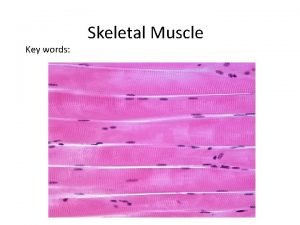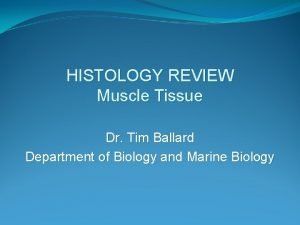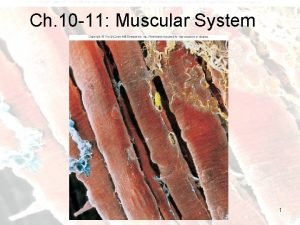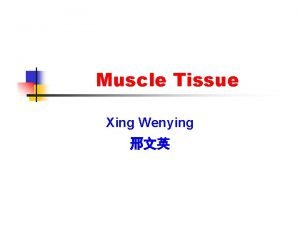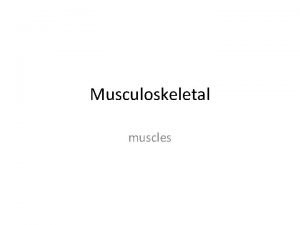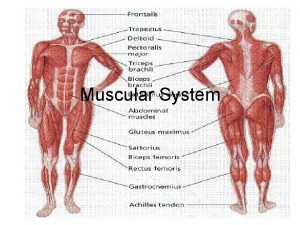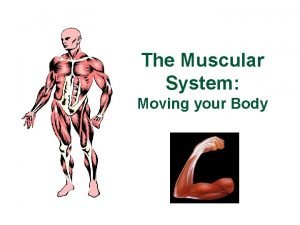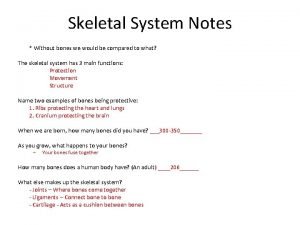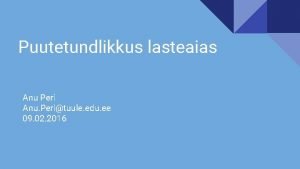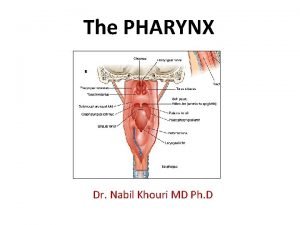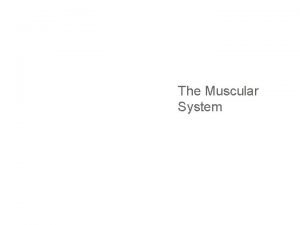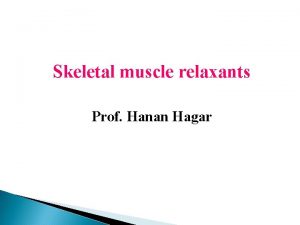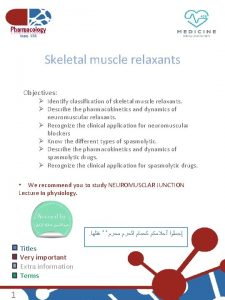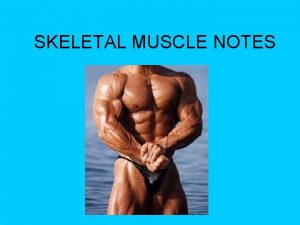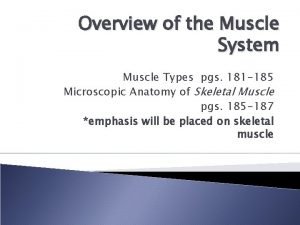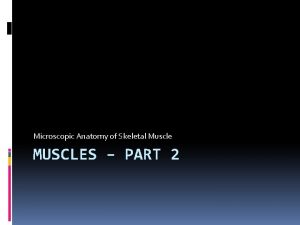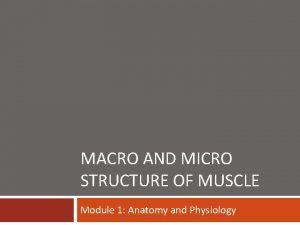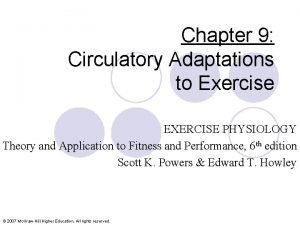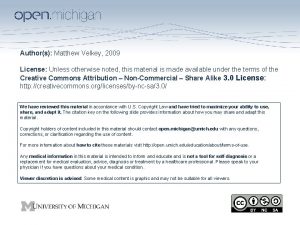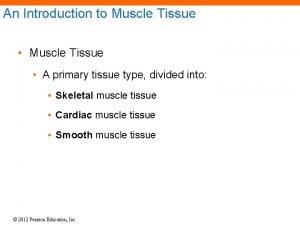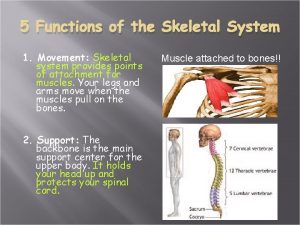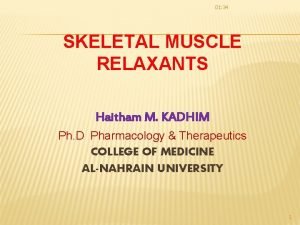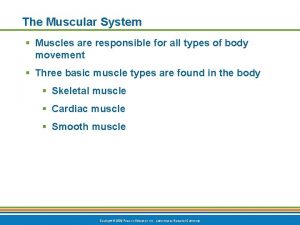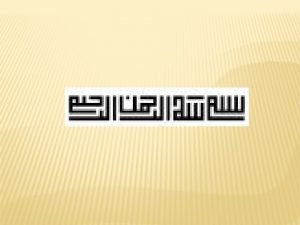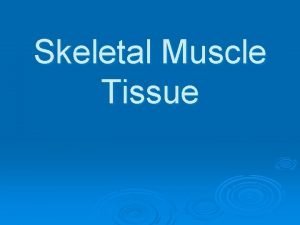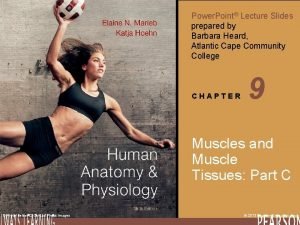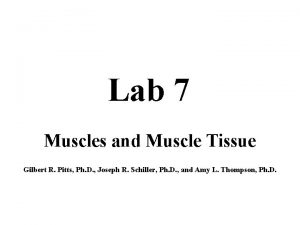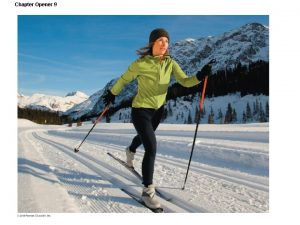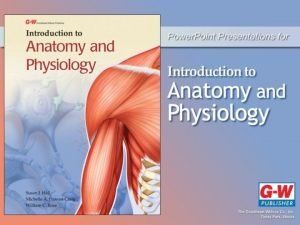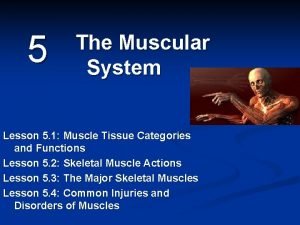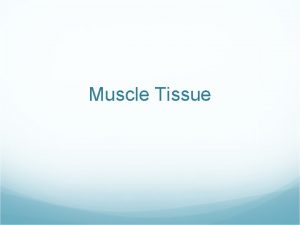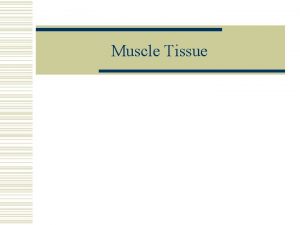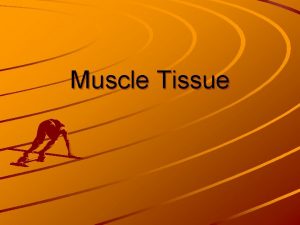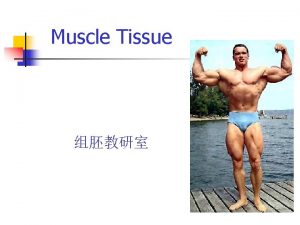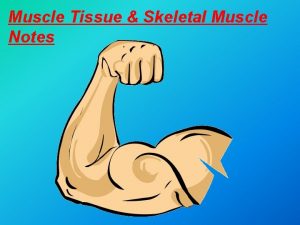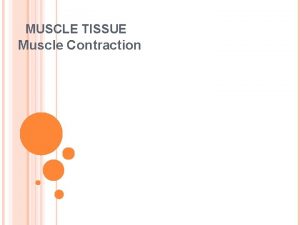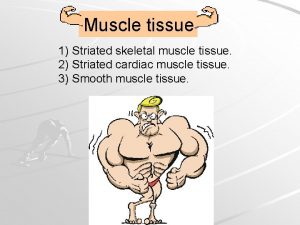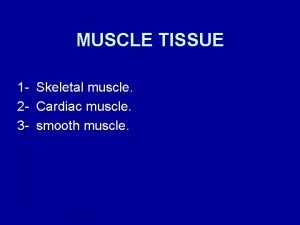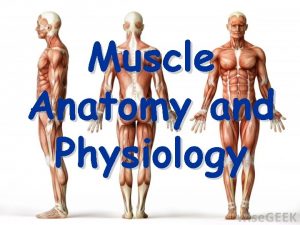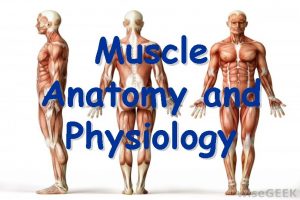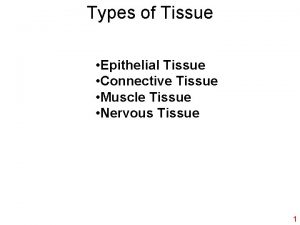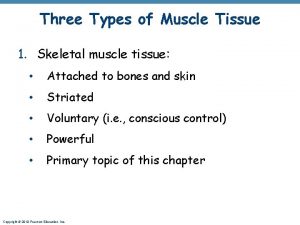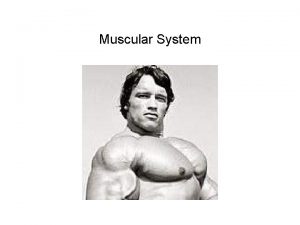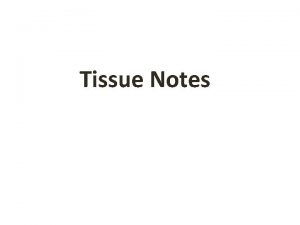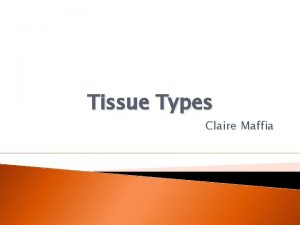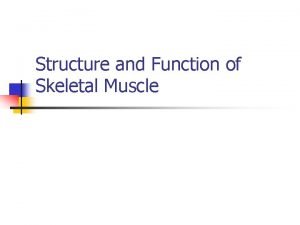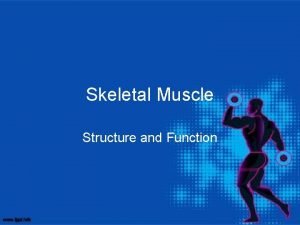Muscle Tissue Skeletal Muscle Notes 3 Types of






































- Slides: 38

Muscle Tissue & Skeletal Muscle Notes

3 Types of Muscle Tissue • Skeletal muscle- striated and voluntary (it is subject to conscious control)

• Smooth muscle- not striated and involuntary (we do not consciously control it) – Lines our digestive system and empties our bladder and bowels

• Cardiac muscle- striated and involuntary – Only found in the heart

Functions of Skeletal Muscle • • Produce movement Maintain posture Support soft tissue Body temperature

THE ANATOMY OF A MUSCLE

Anatomy of Skeletal Muscle • Each muscle is composed of bundles of muscle fibers. • Each muscle fiber (cell) has many nuclei and is a cluster of myofibrils • Myofibrils contain two types of protein filaments that are arranged in a regular, over-lapping pattern – Myosin – thicker filament – Actin – thinner filament



Sarcomere • The functional unit of contraction in skeletal muscle myofibrils • Located between two Z lines • One end of each actin filament is attached to the Z line • Myosin filaments are located between two actin filaments and overlap them on each end

CW: Color and Label

Muscle Tissue Anatomy • Epimysium - outer covering of muscles • Fascicle - a bundle of muscle fibers

Muscle Tissue Anatomy • Perimysium - each fascicle is covered by the perimysium • Endomysium - thin covering around each muscle fiber - Both perimysium & endomysium contain blood vessels and nerve endings

Muscle Tissue Anatomy • Myofibrils - each muscle fiber (muscle cell) contains bundles of myofibrils

• Sarcomere – tiny contractile units that make up myofibrils - Made of 2 proteins: 1. Thin Filaments – made of actin 2. Thick Filaments – made of myosin


• Sarcomere - what gives skeletal muscle its STRIATIONS • A – BAND - area where actin & myosin overlap • I – BAND - area of actin only

• Z – LINES - where I – Bands attach (actin) • Z – Lines are also the boundaries of the sarcomere

Muscle Contractions

Sliding Filament Theory • The myosin filaments pull the actin filaments towards the center of the sarcomere • This shortens the sarcomere which in turn shortens the muscle

Sliding Filament Theory • 1. A neural impulse is sent to the muscle you want to move. • 2. the neuron releases a neurotransmitter called acetylcholine over the surface of a muscle; the neurotransmitter enters the muscle • 3. Neurotrasmitter sacs release calcium

Sliding Filament Theory • 4. Calcium triggers the binding sites on myosin – myosin are uncovered • 5. Actin fibers attach and move up the binding site – z-lines get closer = contraction • 6. Calcium is reabsorbed – binding sites recover – actin releases – z-line moves apart = relaxation

• Pink is actin • Blue is myosin The myosin pulls the actin toward the center of each sarcomere which in turn shortens or contracts the muscle

All-or-None Response • The shortening of the sarcomere occurs along the entire length of the muscle fiber • The strength of a muscle contraction depends on – How often the individual muscle fibers are stimulated to contract – How many muscle fibers contract within a given muscle

Skeletal Muscle Contractions • Controlled voluntarily by the nervous system • Motor Unit – a motor neuron (nerve cell) and all of the muscle fibers it controls

Energy for Muscle Contractions • Energy for muscle contractions comes from ATP (adenosine triphosphate) • Glucose is converted into ATP by mitochondria during cellular respiration

Two Cellular Respiration Pathways • Aerobic Respiration requires a supply of oxygen in order to take place • Produces the maximum number of ATP molecules (36 -38 ATP’s for each glucose molecule converted) • ATP is used in long continuous exercise (distance running)

Two Cellular Respiration Pathways • Anaerobic Respiration occurs when available oxygen has been depleted • Produces only 2 ATP’s per glucose molecule • Also produces Lactic Acid – causes muscle soreness & fatigue • Typically occurs during short periods of intense exercise

Cellular Respiration Summary (glucose) 2 Lactic acid 36 -38

Oxygen Supply • Oxygen is carried to the muscle cells by red blood cells through the circulatory system

Fatigue • Decrease in the strength of muscle contractions due to repeated stimulation without periods of rest • If continued, muscle will lose ability to contract • Occurs when ATP supply is depleted and oxygen is not replenished fast enough – lactic acid builds up in the muscle fibers

Oxygen Debt & Recovery Period • Oxygen debt – amount of oxygen needed to restore pre-exertion oxygen levels • During recovery (rest) period, oxygen is replenished along and more ATP is produced while lactic acid is broken down

Skeletal Muscles • Attached to bones by tendons • Origin – the end of the muscle attached to the bone that remains stationary during a muscle contraction • Insertion – the end of the muscle attached to the bone that moves during a muscle contraction • The insertion always moves toward the origin

Skeletal Muscles • Attached to the bones of the appendicular skeleton in opposing pairs (flexors and extensors) • Flexors – cause the limb to bend at the joint • Extensors – cause them to straighten

Twitch • Single stimulus • Contraction usually followed by a relaxation stimulus • Involuntary – Lack of K and Na gives you cramps

Tetanus • A state of constant contraction

Cramp • a painful, involuntary muscle contraction, usually caused by fatigue or strain – Causes include: • • Poor blood circulation in the legs Overexertion of the calf muscles while exercising Insufficient stretching before exercise Muscle fatigue Dehydration Magnesium and/or potassium deficiency Malfunctioning nerves (pinched nerve in the neck or back)

Injuries • Strain - an injury to the muscles caused by overstretching • Sprain - an injury to the joints caused by overstretching
 Skeletal muscle tissue description
Skeletal muscle tissue description Skeletal muscle tissue
Skeletal muscle tissue Skeletal muscle tissue structure
Skeletal muscle tissue structure T tubules
T tubules Pic of smooth muscle
Pic of smooth muscle Axial muscles
Axial muscles Types of muscle tissue
Types of muscle tissue Skeletal muscle location
Skeletal muscle location Bone family
Bone family õhtujutt vikerraadio
õhtujutt vikerraadio Anatomy of the pharynx
Anatomy of the pharynx 5 golden rules of skeletal muscle activity
5 golden rules of skeletal muscle activity Centrally acting skeletal muscle relaxants
Centrally acting skeletal muscle relaxants Dantrolene
Dantrolene Skeletal muscle relaxants classification
Skeletal muscle relaxants classification Gangelia
Gangelia Movable muscle
Movable muscle Sarcoplasmic
Sarcoplasmic Skeletal muscle relaxants classification
Skeletal muscle relaxants classification Cardiac skeletal and smooth muscle comparison
Cardiac skeletal and smooth muscle comparison Microscopic anatomy of skeletal muscle
Microscopic anatomy of skeletal muscle Epimysium
Epimysium Muscle fiber organization
Muscle fiber organization Skeletal muscle pump
Skeletal muscle pump Spleen histology slide labeled
Spleen histology slide labeled Skeletal muscle contraction steps
Skeletal muscle contraction steps 5 main functions of the skeleton
5 main functions of the skeleton Skeletal muscle relaxants classification
Skeletal muscle relaxants classification Microscopic anatomy of skeletal muscle figure 6-2
Microscopic anatomy of skeletal muscle figure 6-2 Chapter 6 the muscular system figure 6-9
Chapter 6 the muscular system figure 6-9 Nerve supply skeletal muscle
Nerve supply skeletal muscle Skeletal muscle belly
Skeletal muscle belly Slide
Slide Purpose of skeletal muscle
Purpose of skeletal muscle Skeletal muscle cylindrical
Skeletal muscle cylindrical Comparison of skeletal cardiac and smooth muscle
Comparison of skeletal cardiac and smooth muscle Lesson 5.1 the organization of a skeletal muscle
Lesson 5.1 the organization of a skeletal muscle Skeletal muscle neurotransmitter
Skeletal muscle neurotransmitter Lesson 5.1 the organization of a skeletal muscle
Lesson 5.1 the organization of a skeletal muscle
